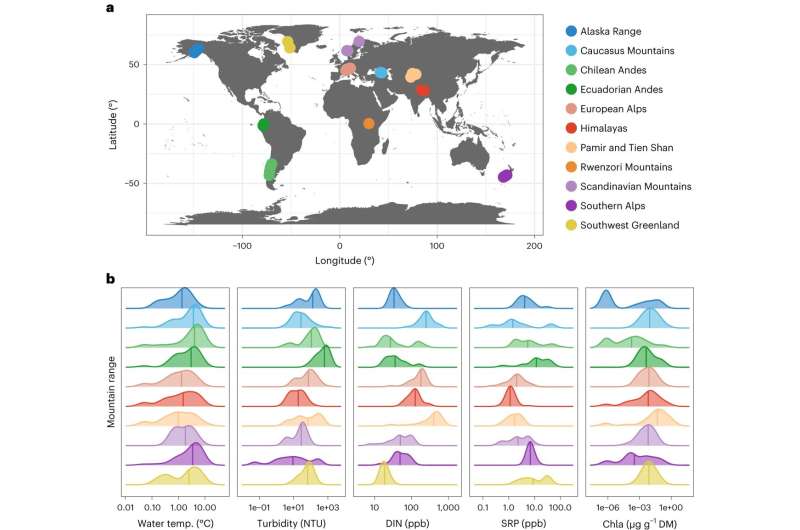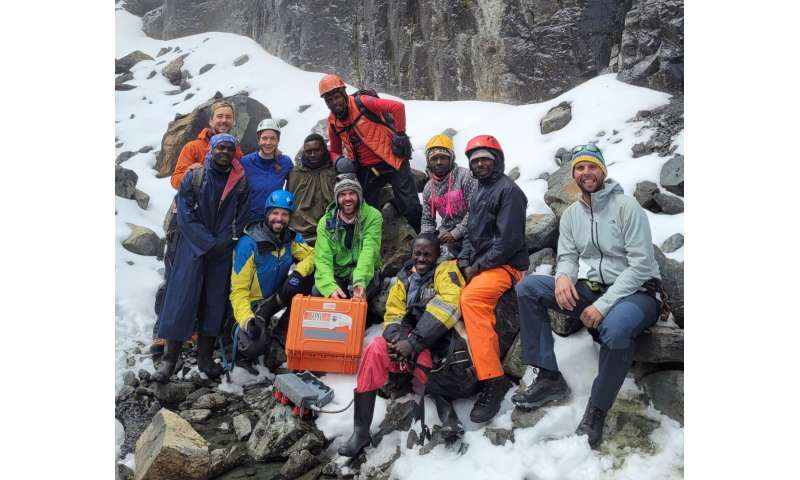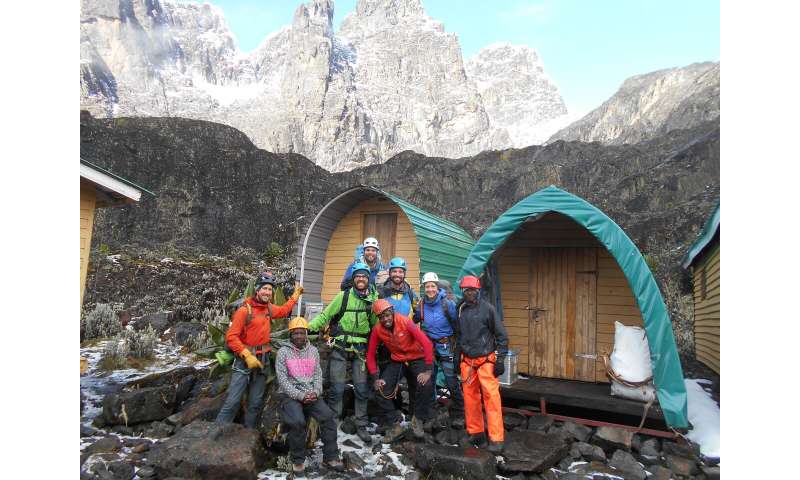This article has been reviewed according to Science X's editorial process and policies. Editors have highlighted the following attributes while ensuring the content's credibility:
fact-checked
trusted source
proofread
Study shows glacier shrinkage is causing a 'green transition'

Glacier-fed streams are undergoing a process of profound change, according to EPFL and Charles University scientists in a paper appearing in Nature Geoscience today. This conclusion is based on the expeditions to the world's major mountain ranges by members of the Vanishing Glaciers project.
Microbial life will flourish in mountain streams because of ongoing glacier shrinkage. This is what a team of scientists from EPFL and Faculty of Science, Charles University, Prague, report in their latest research. Their observations are based on samples collected from 154 glacier-fed streams worldwide as part of the EPFL-led Vanishing Glaciers project.
Glacier-fed streams are murky, raging torrents in the summer. Large quantities of glacial meltwater churn up rocks and sediment, allowing very little light to reach the streambed, while freezing temperatures and snow in other seasons provide little opportunity for a rich microbiome to develop.
But, as glaciers shrink under the effects of global warming, the volume of water originating from glaciers is declining. That means the streams are becoming warmer, calmer, and clearer, giving algae and other microorganisms an opportunity to become abundant and to contribute more to local carbon and nutrient cycles.
"We're witnessing a process of profound change at the level of the microbiome in these ecosystems—nothing short of a 'green transition' because of the increased primary production," says Tom Battin, a full professor at EPFL's River Ecosystems Laboratory (RIVER).
-

The pictures were taken in Uganda in 2022, in the context of the "Vanishing Glaciers" research program. Credit: EPFL / Matteo Tolosano -

The pictures were taken in Uganda in 2022, in the context of the "Vanishing Glaciers" research program. Credit: EPFL / Matteo Tolosano
Changing composition
In their paper, the scientists looked at the nutrients, such as nitrogen and phosphorus, in the stream water as well as the enzymes that microorganisms living in the streambed sediment produce in order to use these nutrients.
Then, they looked at changes in both of these over a very large gradient of streams fed by glaciers that differ in size.
"Glacier-fed-stream ecosystems generally have limited quantities of carbon and nutrients, particularly phosphorous," explains Tyler Kohler, a former postdoc at RIVER and the paper's lead author.
"As glaciers shrink and the demand for phosphorus by algae and other microorganisms grows, phosphorus may become more limiting in high-mountain streams." Hence phosphorus, a critical building block for life, will become even more rare in downstream ecosystems, with yet unknown impacts for their food webs.
These findings are supported by a paper published in Royal Society Open Science in August 2023 by scientists from the Vanishing Glaciers project. In this study, the authors analyzed the microbiome of a small glacier-fed stream in the Rwenzori Mountains, in Uganda, where the "green transition" was already at an advanced stage. Here, the nutrient and enzyme composition was also much different, and algae were abundant.
"What's happening with the Rwenzori glacier gives us a glimpse of what Swiss glacier-fed streams will look like 30 or 50 years from now," says Battin. One outcome of this change is that as glacier-fed streams host more microbial life, they will play a bigger role in biogeochemical cycles such as CO2 fluxes.
The RIVER team plans to build on this research. They are conducting a census of the microbial biodiversity in glacier-fed streams and, using various lines of genomic information, are exploring how diverse microorganisms are able to dwell in one of Earth's most extreme freshwater ecosystems.
Tyler Kohler, lead author and currently a researcher at the Department of Ecology at Faculty of Science, Charles University, Prague was responsible for sample collection during expeditions, laboratory analyses, and writing of the manuscript. Tyler is currently the PI of a Charles University PRIMUS project titled: "Green New World: Unraveling microbial community assembly patterns in vanishing glacier-fed streams."
In this project, Tyler's team is further continuing this research by focusing on how the algal communities (specifically diatoms) are changing in glacier-fed streams with climate change.
More information: Tyler J. Kohler et al, Global emergent responses of stream microbial metabolism to glacier shrinkage, Nature Geoscience, (2024). DOI: 10.1038/s41561-024-01393-6. www.nature.com/articles/s41561-024-01393-6
Michoud, G. et al, The dark side of the moon: first insights into the microbiome structure and function of one of the last glacier-fed streams in Africa, Royal Society Open Science, (2023). DOI: 10.1098/rsos.230329
Provided by Charles University




















